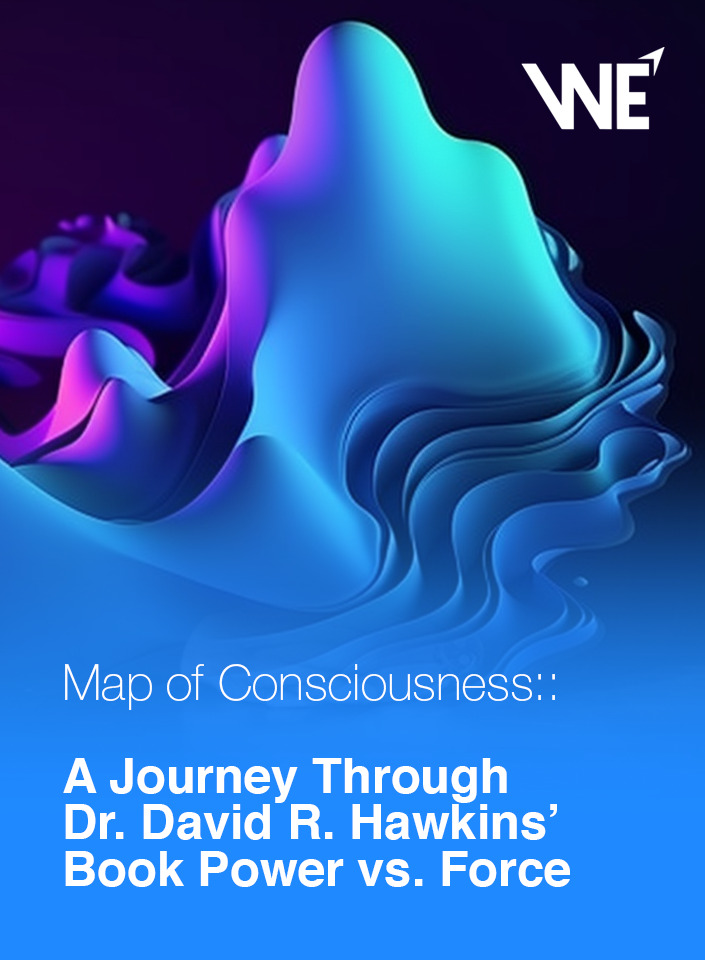The Map of Consciousness, as presented in Dr. David R. Hawkins’ groundbreaking book, ”Power vs. Force,” is a fascinating and insightful tool for personal growth and understanding human behavior. This concept provides a framework for exploring the varying levels of human consciousness and the qualities associated with each level. By grasping the essence of each stage, we can better understand ourselves and others, leading to a more fulfilling and harmonious life.
Below, we briefly explore each level of consciousness, highlighting the keywords and concepts associated with them.
- Shame (20)
At the lowest level of the Map of Consciousness, shame is characterized by humiliation, self-loathing, and worthlessness. People at this level often feel powerless and undeserving of love or happiness.
Keywords: humiliation, self-loathing, worthlessness
- Guilt (30)
Guilt is marked by feelings of blame, regret, and unworthiness. Individuals at this level may be trapped in a cycle of self-punishment, dwelling on past mistakes and struggling with forgiveness.
Keywords: blame, regret, unworthiness
- Apathy (50)
Apathy signifies a state of hopelessness and despair, often accompanied by a lack of motivation or interest in life. People at this level may feel stuck, and unable to take action or make positive changes.
Keywords: hopelessness, despair, indifference
- Grief (75)
Grief is characterized by deep sorrow and a sense of loss. Individuals at this level often experience intense emotional pain, which may manifest in feelings of depression, loneliness, or isolation.
Keywords: sorrow, loss, depression
- Fear (100)
At the level of fear, individuals are preoccupied with perceived threats and danger, leading to anxiety, worry, and paranoia. This level of consciousness can be paralyzing, inhibiting personal growth and meaningful connections with others.
Keywords: anxiety, worry, paranoia
- Desire (125)
Desire represents the relentless pursuit of material possessions, success, or approval. Although this level can be motivating, it can also lead to addiction, obsession, and unfulfilled longing.
Keywords: craving, materialism, addiction
- Anger (150)
Anger is marked by resentment, frustration, and a sense of injustice. While it can be a driving force for change, uncontrolled anger can cause destructive behavior and damaged relationships.
Keywords: resentment, frustration, aggression
- Pride (175)
At the level of pride, individuals seek recognition and validation, often manifesting in arrogance, superiority, and a need to be right. This level may lead to a limited perspective and difficulty accepting alternative viewpoints.
Keywords: arrogance, superiority, validation
- Courage (200)
Courage marks the beginning of empowerment and growth, characterized by a willingness to face challenges, take risks, and embrace change. This level paves the way for personal development and self-improvement.
Keywords: bravery, determination, growth
- Neutrality (250)
Neutrality is a state of balance and flexibility, allowing individuals to adapt to different situations without being overly attached to outcomes. At this level, people are better equipped to maintain inner peace and navigate life’s challenges with ease.
Keywords: balance, flexibility, adaptability
- Willingness (310)
Willingness represents an open-minded, cooperative approach to life. Individuals at this level are eager to learn, grow, and contribute positively to the world around them.
Keywords: open-mindedness, cooperation, contribution
- Acceptance (350)
At the level of acceptance, people embrace reality as it is, without resistance or judgment. This level fosters a sense of inner peace and contentment, allowing individuals to maintain emotional equilibrium and live in harmony with themselves and others.
Keywords: inner peace, contentment, harmony
- Reason (400)
The reason is characterized by a thirst for knowledge, logic, and rational thinking. Individuals at this level are capable of deep understanding and problem-solving, often becoming experts in their chosen fields.
Keywords: knowledge, logic, rationality
- Love (500)
Love, as defined in the Map of Consciousness, is a state of unconditional compassion, empathy, and understanding. At this level, people experience a profound connection with others and a genuine desire to contribute to the well-being of all beings.
Keywords: compassion, empathy, connection
- Joy (540)
Joy is a state of unshakable happiness and inner fulfillment, independent of external circumstances. At this level, individuals radiate positivity and find beauty in every aspect of life.
Keywords: happiness, fulfillment, positivity
- Peace (600)
Peace represents a deep sense of serenity, wisdom, and spiritual understanding. People at this level are often regarded as spiritual leaders or enlightened beings, inspiring others through their presence and teachings.
Keywords: serenity, wisdom, spiritual understanding
- Enlightenment (700-1000)
Enlightenment is the pinnacle of human consciousness, characterized by unity with the divine and a profound understanding of the interconnectedness of all existence. Those who reach this level are considered spiritual masters or avatars, transcending the limitations of the ego and embodying universal love.
Keywords: unity, divine, interconnectedness
Conclusion
The Map of Consciousness serves as a powerful guide for personal growth and self-awareness. By understanding the different levels of consciousness, we can identify areas in our lives that require attention and cultivate a more fulfilling and harmonious existence. As we navigate the journey of personal development, the Map of Consciousness can be a valuable tool for introspection, self-improvement, and ultimately, the expansion of our consciousness.


